A strong employee benefits package has always been a powerful hiring and retention tool, helping to differentiate employer brands in a competitive talent market.
In 2025, employee benefits are becoming even more important for companies to get right – with rising employment costs leading to tighter budgets for salary increases and new hire offers.
Employee expectations are also shifting when it comes to what they want from prospective employers. Salaries still matter, but benefits that boost financial security, reduce personal expenses, and improve work-life balance are now just as important.
We know companies are struggling to address this shift – with Ravio’s 2025 Compensation Trends report finding that for 32% of companies, benefits are the biggest challenge when attracting new hires, and 27% when retaining existing talent.
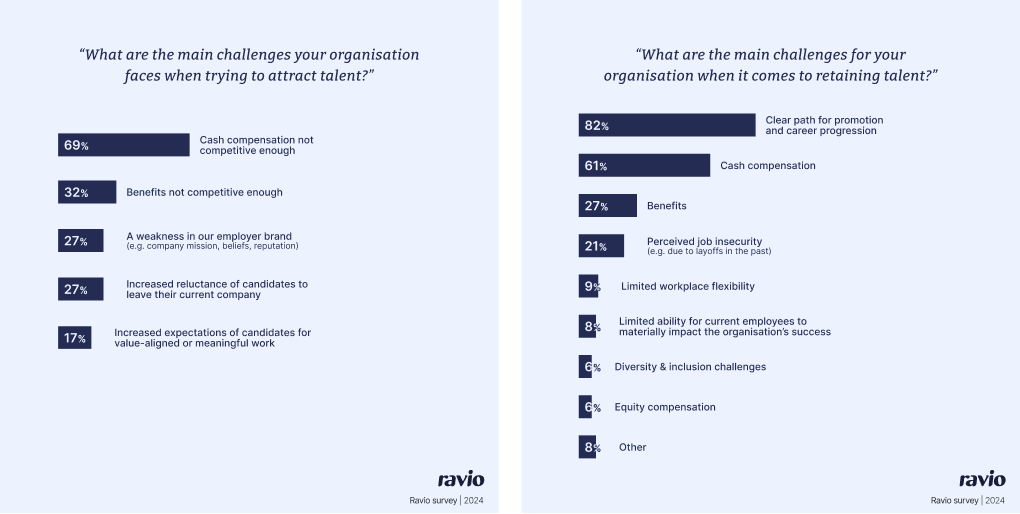
So what do companies do?
Understanding the most valued employee benefits in 2025 is a good starting point.
Subscribe to our newsletter for monthly treasure insights from Ravio's compensation dataset and network of Rewards experts 📩
The top employee benefits in 2025
Using Ravio’s employee benefits benchmarking data, we’ve identified the top 10 employee optional (non-mandatory) benefits across Europe and the US.
Whether you’re assessing how your company stacks up or refining your benefits strategy for the year ahead, here’s what’s leading the way in 2025.
1. Hybrid working model (88%)
The most common benefit in 2025 is hybrid work, offered by 88% of organisations across Europe and the US today.
Hybrid working models are particularly common in the Netherlands, where 97% of companies offer hybrid working, Germany (88% of companies), and France (96% of companies) in 2025.
However, hybrid working does seem to be less common in the US, where only 68% of companies allow employees to work part in-office, part at-home.

While this may not be surprising, it does reflect an important, permanent shift that tech companies have made towards more flexible working models – and how that will be expected by employees in the future.
This is evident in Randstad’s Work Monitor 2025 report, where work-life balance surpassed pay for all age groups – especially younger workers.
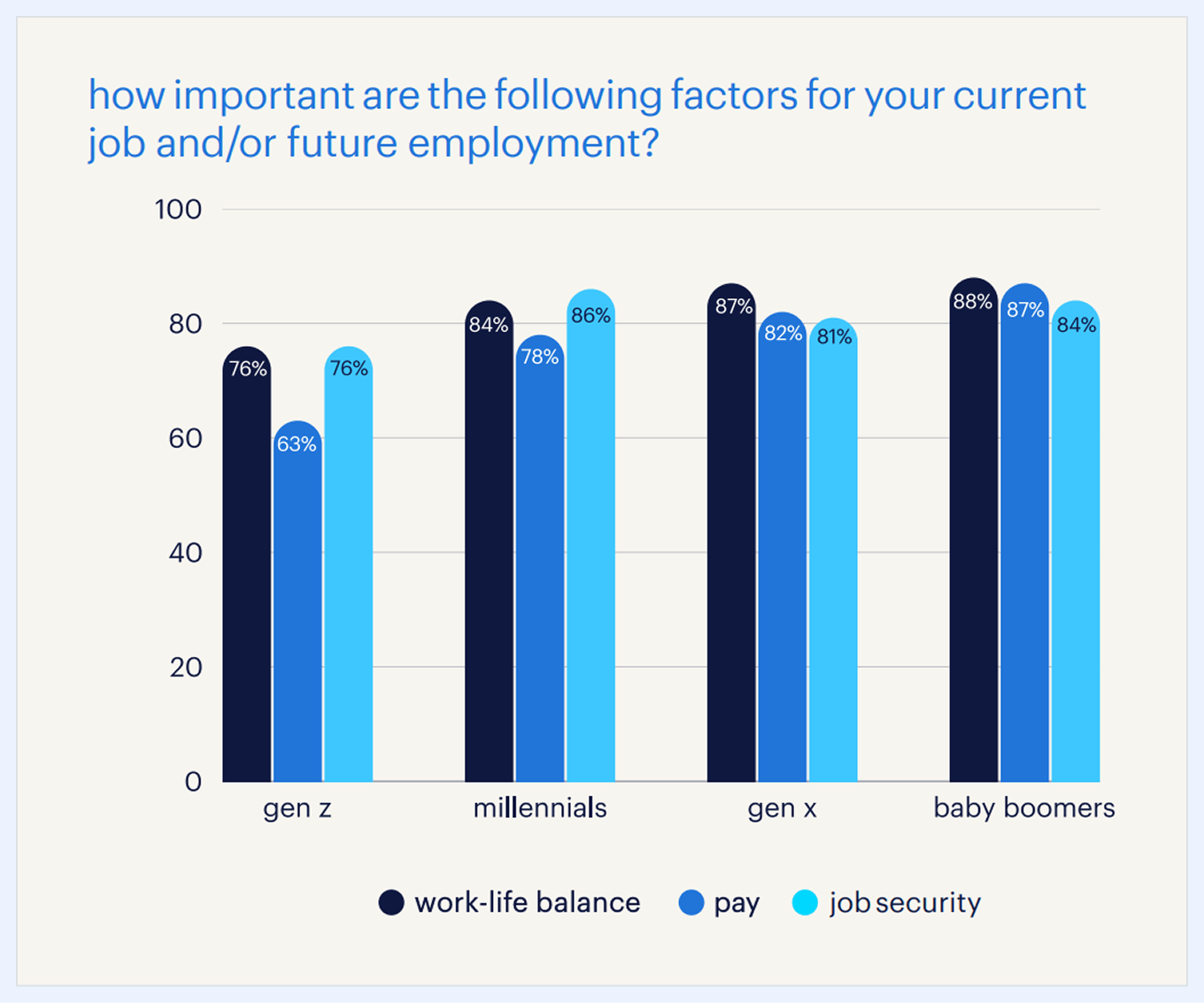
However, the degree of flexibility when it comes to hybrid working does currently vary between different companies and locations. Overall:
- 63% of companies offer hybrid work across 4-5 days, giving employees full autonomy over how often they come into the office.
- 37% of companies have a more structured 1-3 day hybrid model, requiring employees to be in the office for at least part of the week.
Germany and the US have some of the highest adoption rates for 4-5 day hybrid models, while France skews more toward 1-3 days of in-office presence.
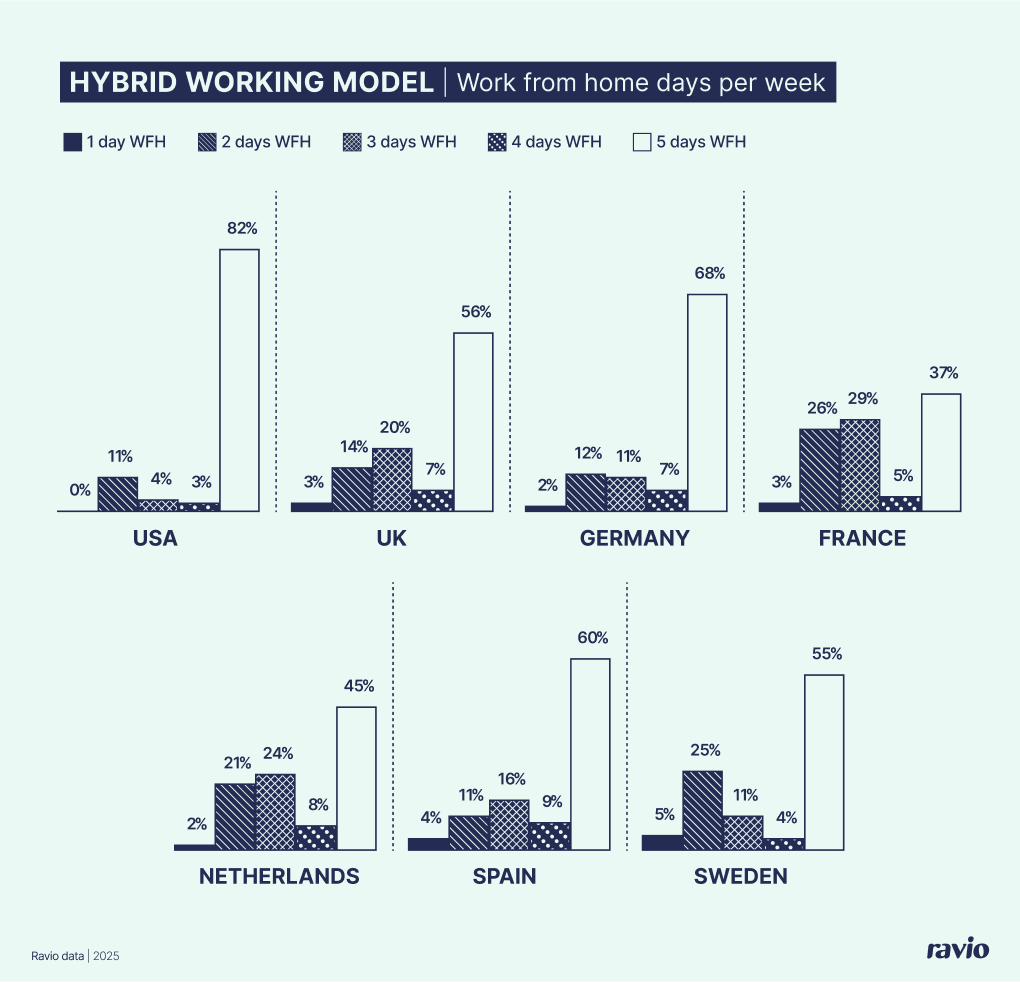
💡Flexible working benefits: What about remote work?
Alongside hybrid working, it has also become more common for companies to offer fully remote working.
Looking at Ravio's dataset, overall, fewer companies offer fully remote working models compared to hybrid working models.
The highest adoption rates for fully remote working are in Sweden and Germany, where 23% and 50% of companies respectively offer fully remote working as an option.
It’s important to note that many companies allow remote working for only certain roles or teams. For example, of the companies in Germany that allow remote working, 24% of them only allow remote working for select roles. For other roles, they may offer hybrid working or fully in-office models.
On the other end of the spectrum, the number of companies requiring employees to be onsite full-time in the tech sector has dropped significantly. Only 17% of organisations now require full-time onsite work, reinforcing the shift away from traditional office environments.
2. Social events (73%)
Company culture remains a top priority for organisations, and 73% of organisations actively invest in team bonding through funding social events as part of their benefits package. Social events can range from in-office gatherings to external team events, and are important for building morale and team culture.
Employers in The Netherlands (83%) and Germany (72%) are particularly likely to provide social events for employees as part of their benefits package.
3. Company training (62%)
Employees today want opportunities to upskill, and companies that invest in learning and development (L&D) programmes see a 32% higher retention rate than those who don’t, according to LinkedIn’s Workplace Learning report in 2025.
It’s likely why 62% of companies provide structured, company-led training programmes to support upskilling and career development. Company training often includes in-house workshops, mentorship programmes, and leadership training.
This is the most popular learning and development benefit across-the-board, with other options much less common – for instance professional development funds which are offered by 39% of organisations.
Interestingly, the UK has the lowest adoption rate of company training at 55%, whereas France leads at 75%. This is likely influenced by French labour laws, which mandate employer contributions toward employee training programs, making employee learning and development a structural part of compensation rather than an optional perk.
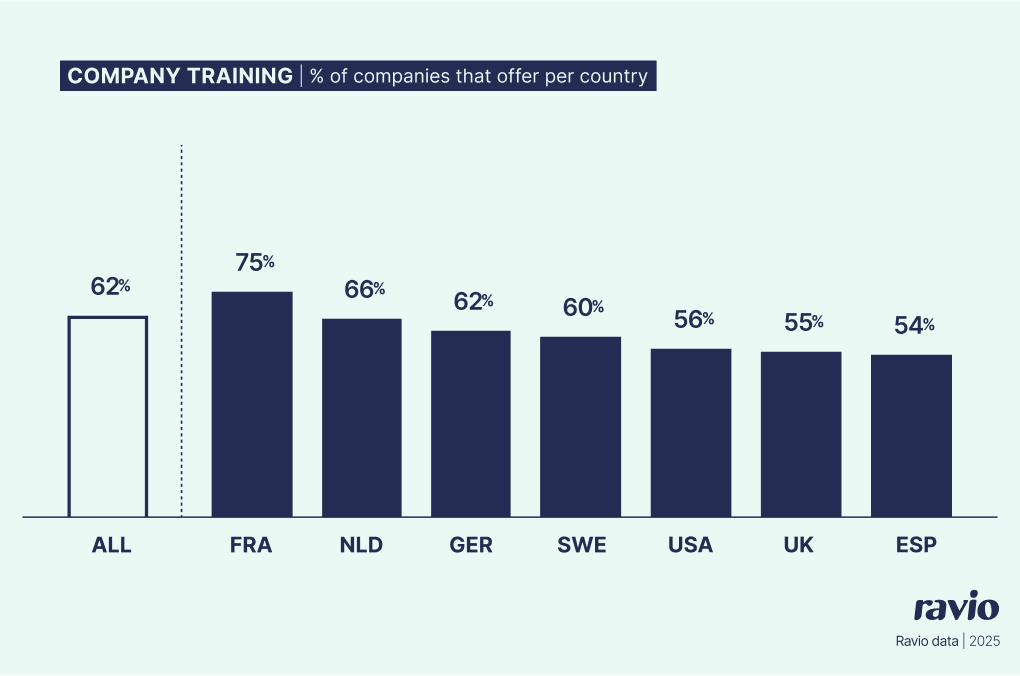
Businesses that invest in these programmes are actively addressing one of the biggest challenges in talent retention.
In fact, according to our latest survey of People and Reward Leaders for Ravio’s 2025 Compensation Trends report, 82% of companies cite career progression and promotion as key issues in keeping employees engaged.
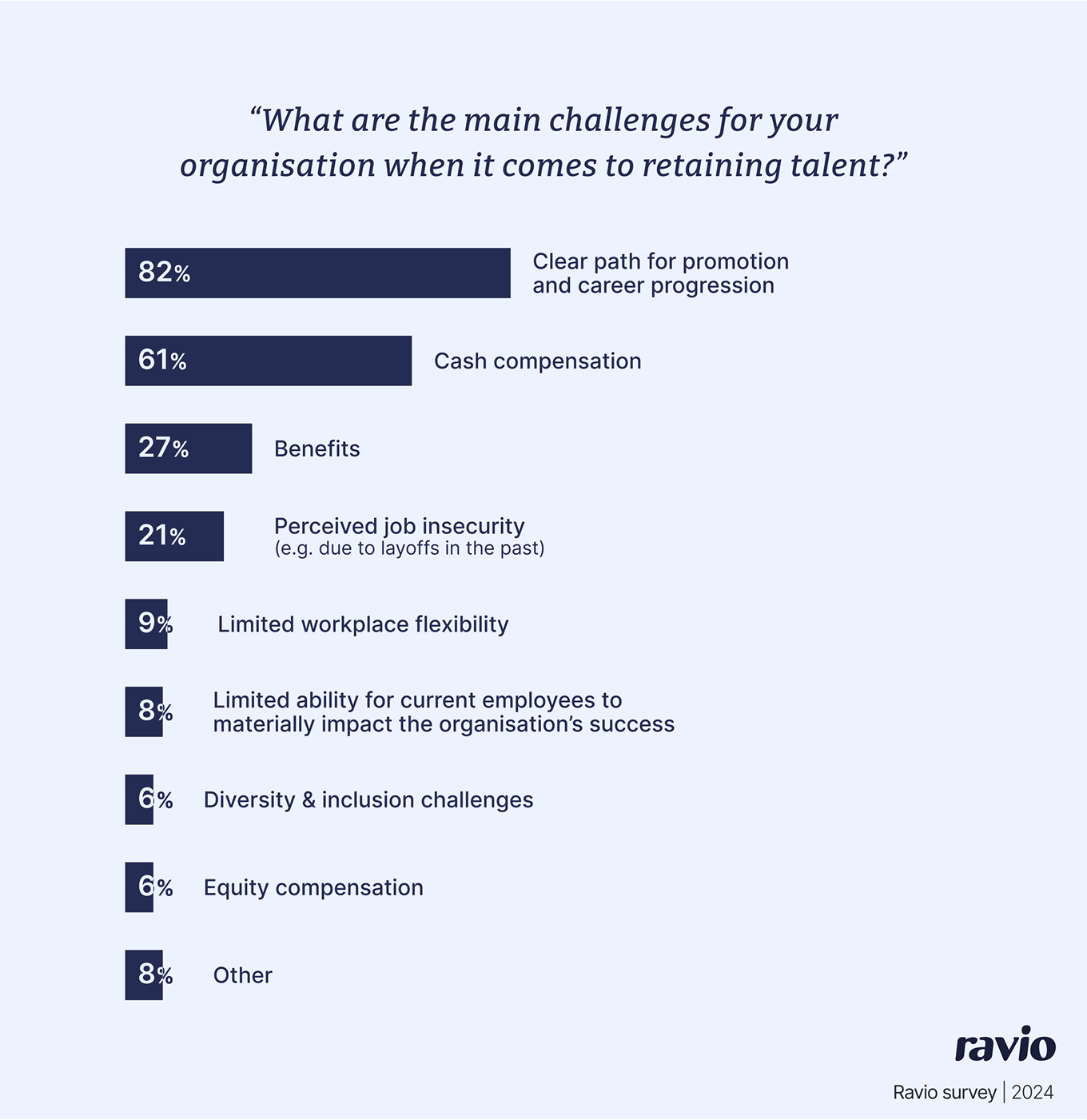
Despite the importance of supporting employees with career growth and progression, learning and development programmes are often one of the first employee benefits to get cut from compensation budgets in years when finances are tighter – which could lead to attrition issues.
In fact, in the same Ravio survey we asked how companies are dealing with tighter compensation budgets whilst still needing to remain competitive in the market. Of those who cited this as a concern, the most common action is to increase cash compensation and fund that through spending cuts, including to the employee learning and development budget.
This is something for People and Reward teams to be mindful of in 2025. Whilst compensation budgets are limited, supporting employee development remains vital for retention objectives, and teams must find ways to balance these two realities.
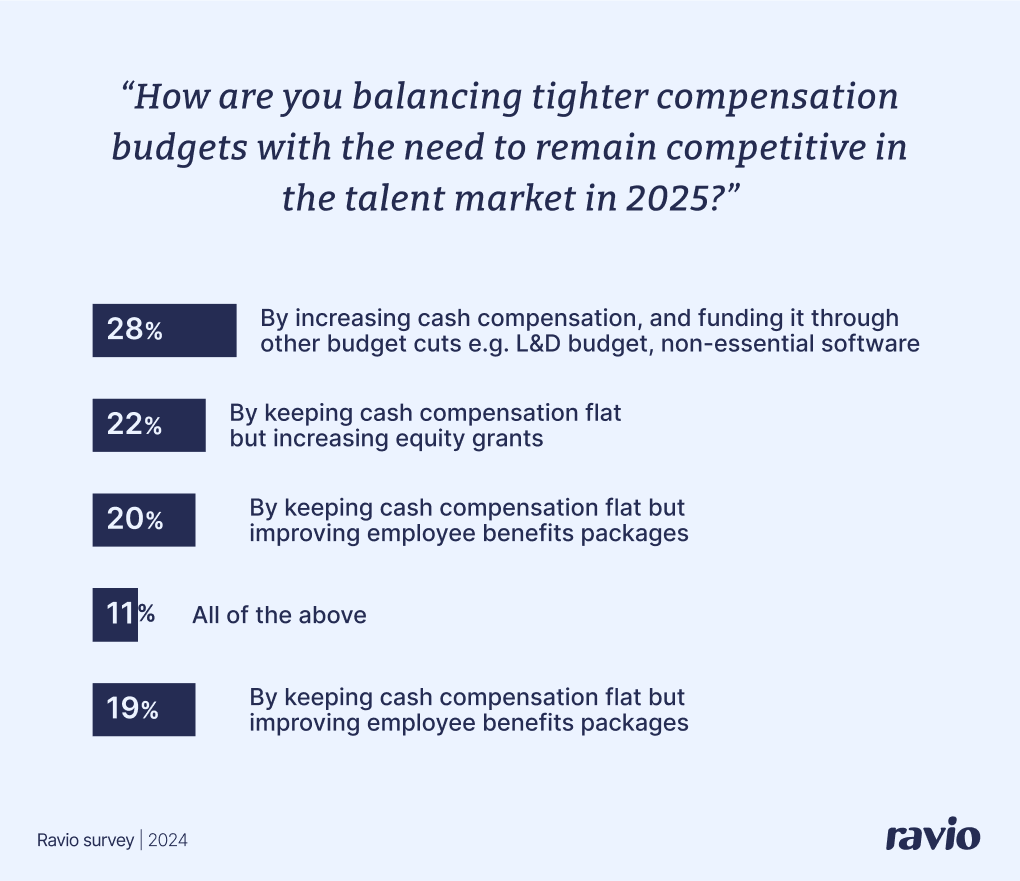
💡What other emerging learning and development employee benefits are out there?
Beyond traditional training, Ravio's employee benefits data shows that companies are investing in coaching, professional development funds, and language programs to broaden employee skill sets and support career growth.
- External coaching and leadership development: The highest adopter is The Netherlands at 37%, while lowest adopter is the US at 4%.
- Language learning: Language courses are particularly popular in non-English-speaking markets. Germany is the highest adopter at 36% while the UK is the lowest adopter at 6%.
- Professional development funds: The highest adopter is the US at 52% while the lowest adopter of professional development budgets as an employee benefit is France at 23%.
4. Gifts and swag (53%)
53% of companies offer gifts or company-branded merchandise as a perk. This could be anything from welcome kits (mugs, t-shirts, tote bags) to birthday or work anniversary gifts.
This is relatively consistent across locations. However, France is a notable exception for being much lower – only 36% of French employers offer gifts and swag as an employee perk.
While not a major decision-maker for employees, branded swag reinforces company identity and helps build a sense of belonging.
5. Private healthcare (51%)
Ravio data shows that 51% of companies now offer private healthcare coverage, reflecting that supporting employee health is becoming more important.
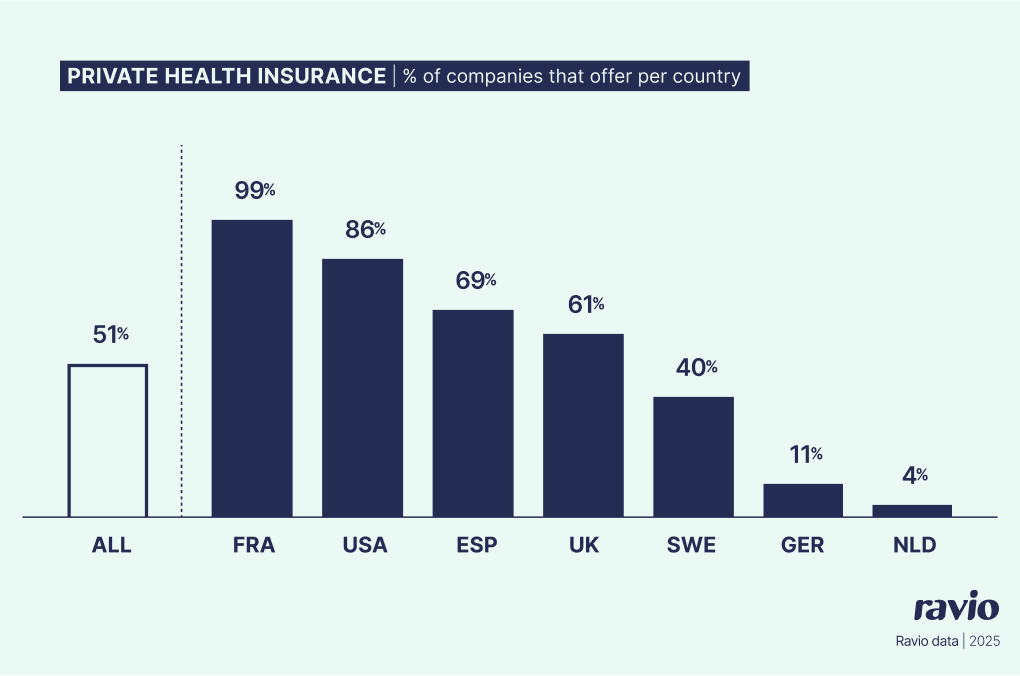
In the UK 61% of companies offer private healthcare as a benefit.
The UK has state-provided healthcare via the NHS, but rising pressure on the public health service has led to longer wait times over recent years. This has likely made private health insurance a much more attractive employee benefit, explaining the high adoption, with many employees seeking faster access to specialists and elective treatments through private providers.
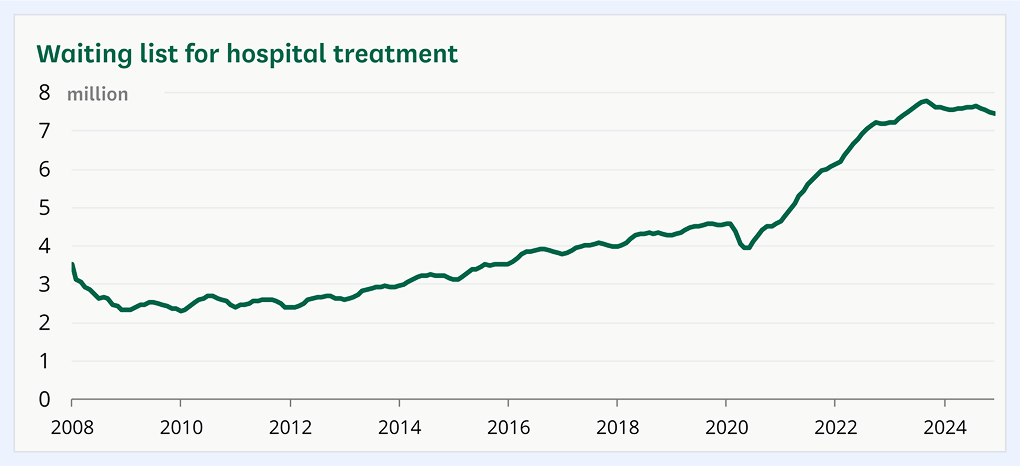
Source: House of Commons Library, Research Briefing February 2025, 'NHS key statistics: England'
Private healthcare could also be becoming a more popular and expected employee benefit because of global companies with distributed teams increasingly offering private healthcare to ensure consistency in benefits, regardless of where employees are based.
In other countries such as Germany, private healthcare remains far less common as a benefit for employees.
Only 11% of German companies offer private healthcare – likely because employees are automatically enrolled in a state-provided health insurance system, with higher earners choosing to opt in for private insurance if they earn an annual salary of £73,900 (as of 2025). Because private health insurance is less needed, it becomes less valuable as an add-on for employees.
Meanwhile, the US continues to have the highest adoption of employer-sponsored healthcare, with 86% of companies offering private plans due to the lack of universal health coverage.
💡What other healthcare employee benefits are proving popular?
While private healthcare trumps a lot of other healthcare benefits on offer, it’s not to say they aren’t important or valued by workers.
Other commonly offered employee benefits in Europe and the US include:
- Dental and vision insurance: Highest adopter is the US at 71%, lowest adopter is The Netherlands at 1%.
- Disability: Highest adopter is the US at 50%, lowest adopter is France at 1%.
- Life insurance: Highest adopter is Sweden at 58%, lowest adopter is Germany at 1%.
- Fitness allowance: Highest adopter is Sweden at 92%, lowest adopter is France at 30%.
- Mental health subscription: Highest adopter is The Netherlands at 40%, lowest adopter is France at 18%.
6. Home office allowance (50%)
As hybrid working – and even full-time remote working – has become the norm, it’s shaped employee expectations when it comes to kitting out their home with the right tech.
Ravio data shows that 50% of companies offer a home office allowance, helping employees invest in ergonomic furniture, technology, and other essentials needed for a productive setup outside of the office.
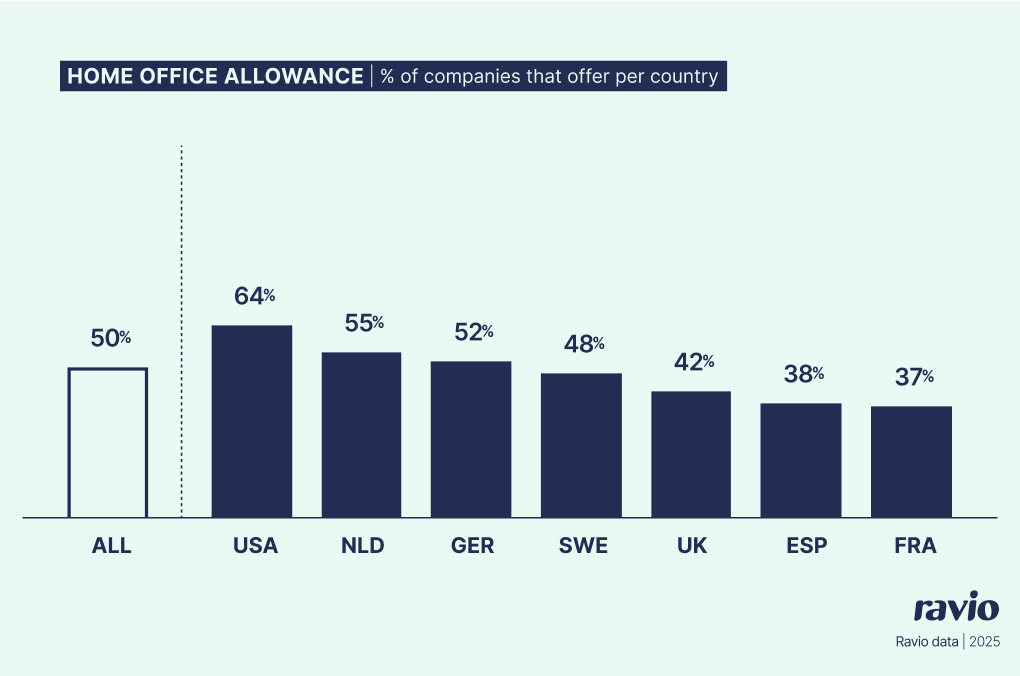
7. Enhanced pension contributions (48%)
Ravio data shows that 48% of companies offer pension contributions above the statutory minimum, recognising the role financial support plays in employee retention and satisfaction.
Pensions are likely to become a more and more crucial part of the overall benefits package.
Research from Goldman Sachs indicates that Millennials are saving for retirement at higher rates than previous generations, influenced by economic uncertainty, the decline of traditional pension schemes, and rising living costs. Younger employees are prioritising long-term financial stability earlier in their careers, making generous pension contributions a highly attractive benefit.
How enhanced pension contributions are offered varies from company to company and from location to location – as different countries have different mandatory requirements when it comes to pensions.
In the UK, for instance, the statutory minimum is a 3% pension contribution by the employer and 5% by the employee. Amongst companies who go beyond this, the most common approach is to match the employee contribution, with 22% of companies offering a 5% employer contribution.
The Netherlands, in contrast, have a state pension system which legally requires employees to contribute 17.9% of their income (deducted by income tax) as well as a workplace pension which has no legal requirement for contribution by either employer or employee. However, it’s very common, with 78% of companies in the Netherlands offering pension contributions. Interestingly, it’s most common for Netherlands employers to offer pension contributions of 10%+ (22% of companies), even though they have no legal requirement at all.
No matter the approach, organisations that fail to keep pace may find themselves at a competitive disadvantage if they only follow the statutory minimum for pensions.
📊 Want to see how your company’s benefits stack up?
Access Ravio’s benefits benchmarking data to compare your offerings against thousands of tech companies across Europe and the US.



